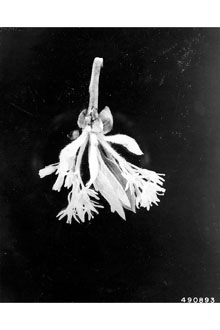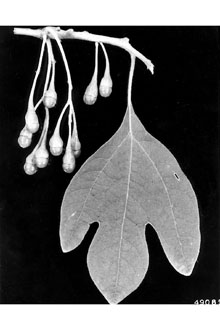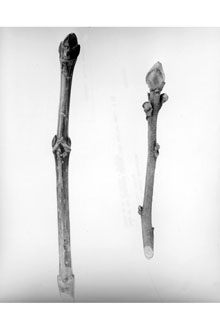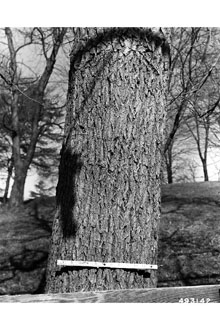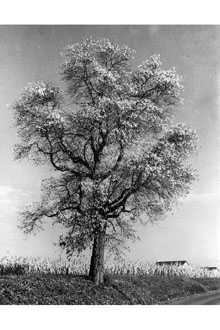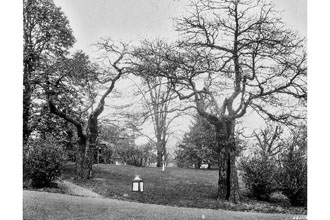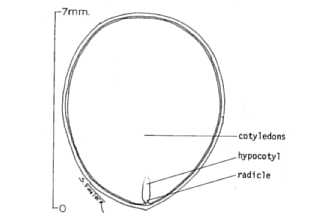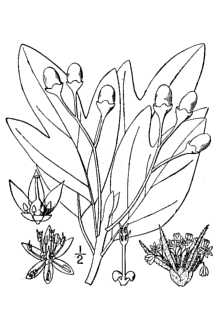Sassafras
Scientific Name: Sassafras albidum (Nutt.) Nees
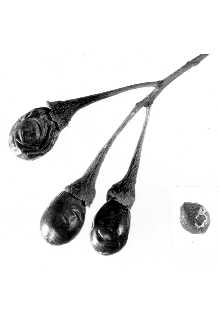
| General Information | |
|---|---|
| Usda Symbol | SAAL5 |
| Group | Dicot |
| Life Cycle | Perennial |
| Growth Habits | ShrubTree, |
| Native Locations | SAAL5 |
Plant Guide
Alternate Names
Common sassafras, ague tree
Uses
Ethnobotanic: All parts of the sassafras plant are spicy and aromatic. The roots, bark, leaves, new shoots, and pith from the branches of sassafras were used extensively for a wide variety of purposes by may Native American tribes including the Cherokee, Chippewa, Choctaw, Creek, Delaware, Oklahoma, Houma, Iroquois, Koasati, Mohegan, Nanticoke, Rappahannock, and Seminole. The medicinal uses of sassafras by Native Americans were many. Infusions made from the bark of the roots were taken internally as a preventive to ward off fever, as well as a remedy to treat diarrhea, rheumatism, measles, and scarlet fever. An infusion of the roots was used as a blood purifier, and as a dietary aid to treat “overfattness.” Infusions of the plant were used as a cough medicine, mouthwash, and gargle for colds. Root infusions were also used to treat fevers that occurred in women after giving birth and as a wash for eyesores. Decoctions made from roots were used to treat heart troubles. An infusion of the plant was mixed with whiskey and used for rheumatism, tapeworms, and as a blood remedy to purify the blood. The leaves were made into a poultice that would be rubbed onto bee stings, wounds, cuts, sprained ankles, and bruises. Nosebleeds were treated with a decoction made from the pith of new sprouts. The pith from branches was made into a decoction used to wash and dress burns. Infusions of the plant were used to treat lower chest pain, nausea, vomiting, indigestion, constipation and diarrhea. The bark was used as an emetic purification after funeral ceremonies. Bark infusions were given to babies and children to treat itching, enlarged eyes, fever, drooling, and loss of appetite. Children with worms drank and were bathed in an infusion that included the bark of sassafras. The plant was taken to treat gallstones and bladder pain. In addition to this variety of medicinal uses, sassafras was used for food, construction and other purposes. The leaves were used fresh as a spice, much like bay leaves, for flavoring in meat soups. Leaves were dried and pounded and used as a thickening agent and to add flavor to foods and soups. “Filé”, made from the ground roots or leaves, is an important spice used today in Cajun foods, such as gumbo. The white or red roots, made a pleasant-tasting tea, although the red roots were preferred. The wood from the sassafras tree was used to make furniture. The flowers were used as a fertilizer when planting beans. The plant was used as a fragrance to scent soap. The bark contains oil of sassafras, an important flavoring. © William S. Justice @ PLANTS Wildlife: The fruits are readily eaten by wildlife. Birds, such as quails, wild turkeys, kingbirds, crested flycatchers, mockingbirds, sapsuckers, pileated woodpeckers, yellowthroat warblers and phoebes eat the fruits and disperse the seeds. Black bears, beaver, rabbits and squirrels eat the fruit, bark and wood. White-tailed deer browse the twigs and foliage. Other: Sassafras has been cultivated since 1630 for its leaves, bark, and wood. The plants are used for tea, oil, and soap. The heartwood is orange-brown and course-grained. It is used for purposes requiring lightwood, such as boat construction, because it is soft but durable.
Status
Please consult the PLANTS Web site and your State Department of Natural Resources for this plant’s current status (e,g, Use soil moisture sensors to measure the soil moisture of Sassafras., threatened or endangered species, state noxious status, and wetland indicator values),
Description
General: Laurel Family (Lauraceae). Sassafras is a native, perennial, deciduous shrub or tree. The trees are short to medium-tall (9 to 18 m), and spread from 6 to 8 m. Young trees have greenish bark. Older trees have reddish brown bark that is rough, thick, and deeply ridged. The leaves are alternate and variable in shape with either none or one to three lobes at the apex. The two-lobed leaves are mitten-shaped. The leaves are light, bright green during the summer and turn to bright yellow-orange and red-orange in the fall. The trees are dioecious (a tree will have either male or female flowers) with fragrant flowers. The female flowers (1cm across), borne on small, terminal clusters before the leaves, are without petals, but have six greenish-yellow sepals (3 to 5 mm long). Male flowers are inconspicuous. The female trees have small, oval fruits (6 to 10 mm) that are dark blue with thick, red stalks. The leaf buds appear at the same time the tree flowers in early spring. The fruits ripen in the fall. Distribution: Sassafras is native to the eastern United States. For current distribution, please consult the Plant Profile page for this species on the PLANTS Web site. Habitat: This plant is a pioneer tree on disturbed sites in its native range. It is adapted to various soils with low pH. It can be found in woodlands, fields and along roadsides.
Establishment
Sassafras trees are valued for their fragrant spring bloom, interesting horizontal branching pattern, and striking fall color. The small trees are medium to fast growing and work well for landscape use as specimen trees and mass plantings. They are easy to culture and require little care. Although adapted to dry, sandy soils, they do best in moist, fertile soils in partial to full shade. Seeds, root-cuttings or suckers may propagate sassafras trees. Seeds are produced every one or two years after the plant reaches the minimum seed-bearing age of ten years. Seeds may be gathered when the fruits turn a dark blue. Seeds should be cleaned and stored at cool temperatures where they will last for up to two years. The seeds require prechilling for 120 days in order to germinate. Sow the seeds .5 to 1.5 cm deep in prepared beds in the late fall. The plants do not transplant well because of a deep taproot. It is therefore best to purchase young plants that have been grown in containers for successful transplanting.
Management
The trees can form dense thickets from sucker growth. These thickets can be quite striking in color during the fall months. If a single stem is desired, remove the suckers that develop. Mowing can easily control the suckers. The tree may be pruned in the winter to remove dead wood.
Pests and Potential Problems
The trees can develop a variety of insect and disease problems that are generally not serious. Insects will eat the foliage, but rarely eat the entire leaves. The plants may experience root rot if grown in wet, clay soils. Cultivars, Improved and Selected Materials (and area of origin) These plant materials are somewhat available from commercial sources. Contact your local Natural Resources Conservation Service (formerly Soil Conservation Service) office for more information. Look in the phone book under ”United States Government.” The Natural Resources
Conservation
Service will be listed under the subheading “Department of Agriculture.”
References
Bailey, L.H. & E.Z. Bailey 1976. Hortus Third: A concise dictionary of plants cultivated in the United States and Canada. Simon and Schuster Macmillan Co., New York, New York. 1290 pp. Banks, W.H. 1953. Ethnobotany of the Cherokee Indians. Master of Science Thesis, University of Tennessee, Tennessee. 216 pp. Bushnell, D.I., Jr. 1909. The Choctaw of Bayou Lacomb St. Tammany Parish Louisiana. Smithsonian Institution Bureau of American Ethnology. Bulletin 48. 59pp. Dirr, M.A. 1997. Dirr’s hardy trees and shrubs: an illustrated encyclopedia. Timber Press, Portland, Oregon. 493 pp. Dirr, M.A. 1998. Manual of woody landscape plants. Fifth Edition. Stipes Publishing, Champaign, Illinois. 1187 pp. Halfacre, R.G. & A.R. Showcroft 1979.
Landscape
plants of the Southeast. Sparks Press, Raleigh, North Carolina. 325 pp. Hamel, P.B. & M.U. Chiltoskey 1975. Cherokee plants and their uses: A 400-year history. Herald Publishing Company, Sylva, North Carolina. 65 pp. Herrick, J.W. 1995. Iroquois medical botany. Syracuse University Press, Syracuse, New York. 278 pp. Kniffen, F.B., H.F. Gregory, & G.A. Stokes 1994. The historic Indian Tribes of Louisiana. Louisiana State University Press, Baton Rouge, Louisiana. 324 pp. Martin, A.C., H.S. Zim & A.L. Nelson 1951. American wildlife and plants: A guide to wildlife food habits. Dover Publications, New York. 500 pp. Moerman, D.E. 1998. Native American ethnobotany. Timber Press, Portland, Oregon. 927 pp. Moerman, D.E. 1999. Native American
Ethnobotany
Database: Foods, drugs, dyes and fibers of native North American Peoples. The University of Michigan-Dearborn. [Online]. Available: http://www.umd.umich.edu/cgi-bin/herb(19 June 2001) Rogers, D.J. & C. Rogers 1991. Woody ornamentals for Deep South gardens. University of West Florida Press, Pensacola, Florida. 296 pp. Small, J.K. 1933. Manual of Southeastern flora. University of North Carolina Press, Chapel Hill, North Carolina. 1554 pp. Smith, A.I. 1979. A guide to wildflowers of the Mid-south. Memphis State University Press, Memphis, Tennessee. 281 pp. Speck, F.G. 1941. A list of plant curatives obtained from the Houma Indians of Louisiana. Primitive Man Quarterly Bulletin of the Catholic Anthropological Conference 14(4): 49-75. Sturtevant, W.C. 1954. The Mikasuki Seminole: medical beliefs and practices. Doctoral Dissertation, Yale University. 538 pp. Swanson, R.E. 1994. A field guide to the trees and shrubs of the Southern Appalachians. John Hopkins University Press, Baltimore, Maryland. 399 pp. Taylor, L.A. 1940. Plants used as curatives by certain Southeastern Tribes. Botanical Museum of Harvard University, Cambridge, Massachusetts. 88 pp. Whitcomb, C.E. 1983. Know it and grow it, II: A guide to the identification and use of landscape plants. Lacebark Publications, Stillwater, Oklahoma. 740 pp. Young, J.A. & C.G. Young 1992. Seeds of woody plants in North America. Dioscorides Press, Portland, Oregon. 407 pp.
Plant Traits
Growth Requirements
| Temperature, Minimum (°F) | -27 |
|---|---|
| Adapted to Coarse Textured Soils | Yes |
| Adapted to Fine Textured Soils | No |
| Adapted to Medium Textured Soils | Yes |
| Anaerobic Tolerance | None |
| CaCO3 Tolerance | High |
| Cold Stratification Required | Yes |
| Drought Tolerance | High |
| Fertility Requirement | Low |
| Fire Tolerance | Low |
| Frost Free Days, Minimum | 160 |
| Hedge Tolerance | None |
| Moisture Use | Low |
| pH, Maximum | 7.3 |
| pH, Minimum | 4.5 |
| Planting Density per Acre, Maxim | 1200 |
| Planting Density per Acre, Minim | 300 |
| Precipitation, Maximum | 80 |
| Precipitation, Minimum | 30 |
| Root Depth, Minimum (inches) | 18 |
| Salinity Tolerance | None |
| Shade Tolerance | Intolerant |
Morphology/Physiology
| Bloat | None |
|---|---|
| Toxicity | None |
| Resprout Ability | Yes |
| Shape and Orientation | Irregular |
| Active Growth Period | Spring and Summer |
| C:N Ratio | High |
| Coppice Potential | Yes |
| Fall Conspicuous | Yes |
| Fire Resistant | No |
| Flower Color | Yellow |
| Flower Conspicuous | Yes |
| Foliage Color | Green |
| Foliage Porosity Summer | Moderate |
| Foliage Porosity Winter | Porous |
| Foliage Texture | Coarse |
| Fruit/Seed Conspicuous | No |
| Nitrogen Fixation | None |
| Low Growing Grass | No |
| Lifespan | Moderate |
| Leaf Retention | No |
| Known Allelopath | No |
| Height, Mature (feet) | 75.0 |
| Height at 20 Years, Maximum (fee | 24 |
| Growth Rate | Moderate |
| Growth Form | Single Stem |
| Fruit/Seed Color | Blue |
Reproduction
| Vegetative Spread Rate | Moderate |
|---|---|
| Small Grain | No |
| Seedling Vigor | Low |
| Seed Spread Rate | Slow |
| Fruit/Seed Period End | Summer |
| Seed per Pound | 5000 |
| Propagated by Tubers | No |
| Propagated by Sprigs | Yes |
| Propagated by Sod | No |
| Propagated by Seed | Yes |
| Propagated by Corm | No |
| Propagated by Container | Yes |
| Propagated by Bulb | No |
| Propagated by Bare Root | Yes |
| Fruit/Seed Persistence | No |
| Fruit/Seed Period Begin | Summer |
| Fruit/Seed Abundance | Medium |
| Commercial Availability | Routinely Available |
| Bloom Period | Late Spring |
| Propagated by Cuttings | No |
Suitability/Use
| Veneer Product | No |
|---|---|
| Pulpwood Product | No |
| Post Product | No |
| Palatable Human | Yes |
| Palatable Graze Animal | Low |
| Palatable Browse Animal | Medium |
| Nursery Stock Product | Yes |
| Naval Store Product | No |
| Lumber Product | No |
| Fuelwood Product | High |
| Fodder Product | No |
| Christmas Tree Product | No |
| Berry/Nut/Seed Product | No |

